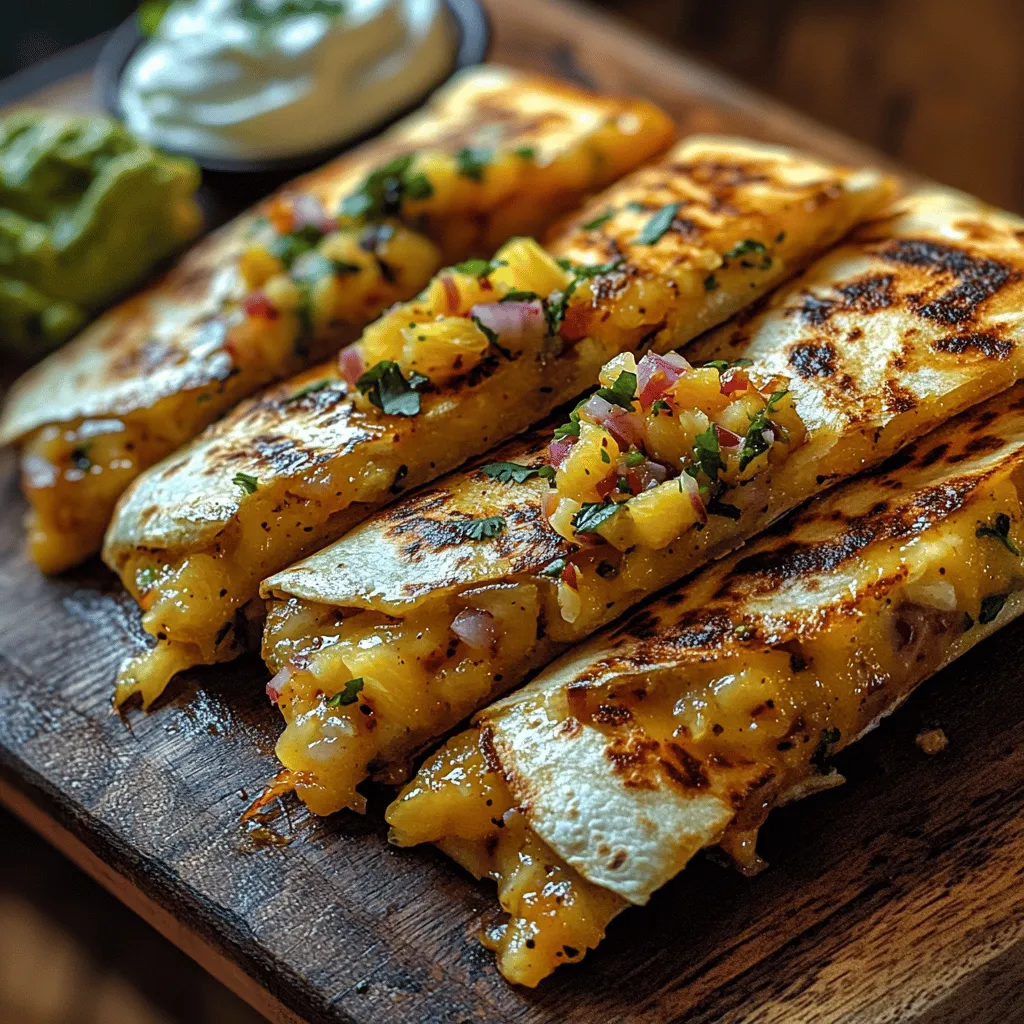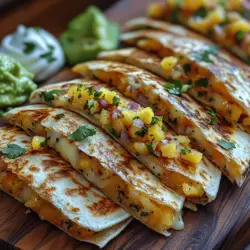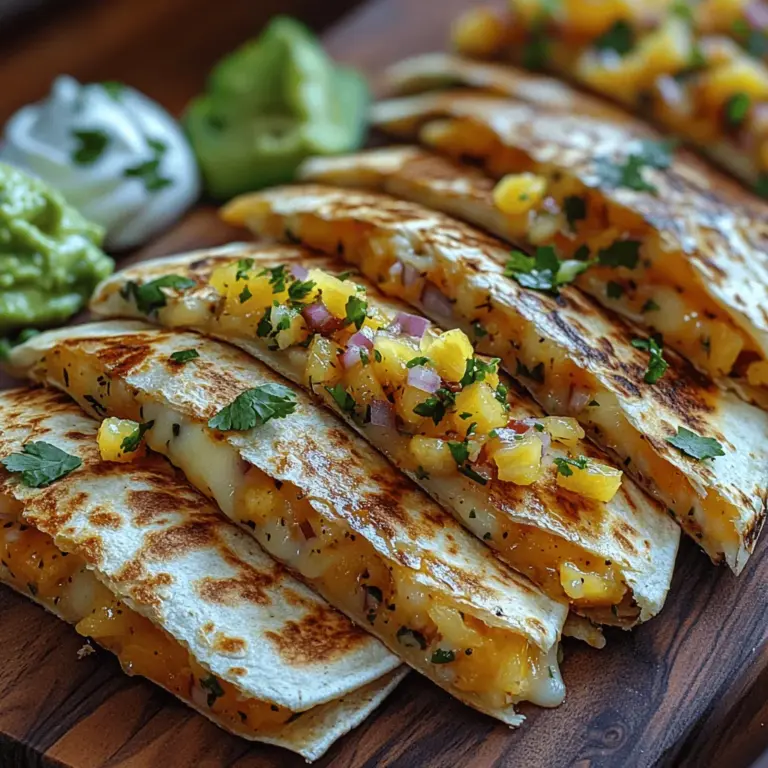Introduction
Welcome to the vibrant world of Zingy Pineapple Salsa Quesadillas! This dish is not just a meal; it’s an experience that brings together the bold flavors of fresh ingredients and the comforting texture of melted cheese. The significance of this recipe lies in its ability to combine sweet and savory elements, creating a delightful harmony that resonates with food lovers across various cuisines. Whether you’re hosting a casual gathering, preparing a quick weeknight dinner, or simply indulging in a personal treat, these quesadillas offer a burst of flavor that is both satisfying and refreshing.
Pineapple salsa has its roots in Latin American cuisine, where fresh ingredients are celebrated and utilized in innovative ways. The combination of pineapple with traditional salsa ingredients not only enhances the flavor profile but also adds a distinct tropical twist that elevates classic quesadillas to new heights. The allure of this dish comes from its versatility; it seamlessly fits into various culinary contexts, from Mexican fiestas to laid-back summer barbecues.
In today’s food culture, the trend of homemade meals has gained significant traction. Making your own Zingy Pineapple Salsa Quesadillas allows you to control the quality of ingredients, adjust seasoning to your taste, and enjoy the satisfaction of crafting a dish from scratch. Plus, preparing food at home often leads to healthier meals, free from preservatives and excessive sodium found in many store-bought alternatives.
Understanding the Key Ingredients
To create the perfect Zingy Pineapple Salsa Quesadillas, it’s essential to understand the key ingredients that bring this dish to life. Each component plays a vital role in the overall flavor and nutritional profile of the quesadilla.
Pineapple
The star of the dish, pineapple, not only adds a sweet and tangy flavor but also boasts a wealth of health benefits. Rich in vitamin C, manganese, and bromelain, pineapple can aid digestion and boost your immune system. When selecting a pineapple, look for one that is firm but slightly soft at the base, with a sweet aroma. A golden-yellow color indicates ripeness, so avoid those that are overly green or have dark spots.
Bell Peppers
Colorful bell peppers add crunch and a mild sweetness to the quesadillas. They are packed with vitamins A and C, making them an excellent addition for boosting your nutrient intake. Choose bell peppers that are firm and shiny, and consider using a variety of colors (red, yellow, and green) for a vibrant presentation.
Red Onion
Red onion brings a sharp, zesty flavor that complements the sweetness of the pineapple. It’s also rich in antioxidants and has anti-inflammatory properties. When selecting red onions, pick ones that are firm and heavy with a smooth skin. Avoid any that have soft spots or signs of sprouting.
Fresh Cilantro
Cilantro adds a fresh, herbaceous note to the salsa. Beyond its flavor, cilantro is known for its potential health benefits, including anti-inflammatory and antibacterial properties. When choosing cilantro, look for bright green leaves without any wilting or yellowing.
Jalapeños
For those who enjoy a kick of heat, jalapeños are a must-have in this recipe. They not only enhance the flavor profile but also provide vitamin C and capsaicin, which has been linked to various health benefits. When selecting jalapeños, choose firm ones with smooth skin. If you prefer milder salsa, consider removing the seeds and membranes, as these contain the most heat.
Flour Tortillas
The base of the quesadilla, flour tortillas, are essential for creating a satisfying wrap for your fillings. Flour tortillas are generally softer and more pliable than corn tortillas, making them ideal for quesadillas. Opt for high-quality tortillas made with minimal ingredients, focusing on whole grain options when possible for added fiber.
Cheese
A blend of cheeses, such as Monterey Jack and cheddar, provides a rich and creamy texture that binds the ingredients together. Cheese is a good source of calcium and protein, but moderation is key. When selecting cheese, look for blocks rather than pre-shredded varieties, as they often contain additives that can affect melting properties.
Equipment and Tools Needed
To prepare your Zingy Pineapple Salsa Quesadillas, you’ll need a few essential kitchen tools that will make the cooking process seamless and enjoyable.
Essential Kitchen Tools
1. Cutting Board: A sturdy cutting board is crucial for chopping your fresh ingredients. Opt for one that is easy to clean and has a non-slip surface.
2. Sharp Knife: A sharp chef’s knife will make slicing through fruits and vegetables much easier and safer. Invest in a good quality knife for precision.
3. Mixing Bowl: You’ll need a mixing bowl to combine your salsa ingredients. A glass or stainless-steel bowl is ideal for mixing and can easily transition to serving.
4. Skillet: A non-stick skillet is perfect for cooking your quesadillas, ensuring that the tortillas brown nicely without sticking. A cast-iron skillet can also add a nice sear.
5. Spatula: A wide spatula will help flip your quesadillas with ease, ensuring even cooking and preventing any spills.
Recommended Brands or Types
– Cutting Board: Look for brands like OXO or John Boos for durable and functional options.
– Knife: Wüsthof and Victorinox are known for their high-quality chef’s knives.
– Skillet: Tefal or Lodge cast iron skillets are great choices for even heat distribution.
Optional Equipment
While the above tools are essential, consider these optional items to enhance your cooking experience:
– Food Processor: If you want to save time chopping ingredients for the salsa, a food processor can help achieve a finely chopped mixture quickly.
– Griddle: If you’re making multiple quesadillas at once, a griddle can accommodate several at a time, speeding up the cooking process.
Step-by-Step Instructions
Now that you’re familiar with the key ingredients and equipment, let’s dive into the step-by-step instructions for preparing Zingy Pineapple Salsa Quesadillas.
Preparing the Ingredients
1. Wash and Chop: Begin by thoroughly washing all your fresh produce. For the pineapple, slice off the top and bottom, then carefully cut away the skin and core before dicing it into small chunks. For the bell pepper, remove the seeds and stem, then chop it into small pieces. Slice the red onion finely, and chop the jalapeños (removing seeds if desired). Finally, chop the cilantro.
2. Mix the Salsa: In a mixing bowl, combine the diced pineapple, bell pepper, red onion, jalapeños, and cilantro. Squeeze in the juice of one lime for brightness and flavor. Season with salt and pepper to taste. Set aside to let the flavors meld while you prepare the quesadillas.
Cooking Process
1. Heat the Skillet: Place a non-stick skillet over medium heat and allow it to warm up. This step is crucial for achieving that perfect golden brown on your quesadillas.
2. Assemble the Quesadillas: Take one flour tortilla and sprinkle a generous amount of cheese on one half. Add a few spoonfuls of the pineapple salsa mixture on top of the cheese, then sprinkle a little more cheese over the salsa before folding the tortilla in half.
3. Cook the Quesadilla: Carefully place the folded quesadilla in the hot skillet. Cook for about 2-3 minutes, checking occasionally to ensure it doesn’t burn. You’re looking for a golden brown color on the tortilla and melted cheese inside.
4. Flip and Finish: Use the spatula to flip the quesadilla over, cooking for another 2-3 minutes on the other side. Keep an eye on the quesadilla to monitor doneness; the goal is to have a crispy exterior and gooey cheese interior.
Final Touches
1. Remove and Cut: Once both sides are golden brown and the cheese is melted, carefully remove the quesadilla from the skillet. Let it cool for a minute, then cut it into wedges using a sharp knife.
2. Plating and Presentation: Arrange the quesadilla wedges on a serving plate and consider garnishing with additional salsa, avocado slices, or a dollop of sour cream. The bright colors of the salsa against the golden quesadilla create an inviting presentation that is sure to impress.
3. Garnishing Suggestions: Fresh lime wedges, extra cilantro, or even a sprinkle of queso fresco can enhance both the flavor and visual appeal of your dish.
Flavor Variations and Customizations
While the Zingy Pineapple Salsa Quesadillas are delicious as is, don’t hesitate to get creative! Substitute the pineapple for mango or peach for a different fruity twist. You can also experiment with different types of cheese, such as pepper jack for an added kick or feta for a more tangy flavor. If you’re looking for a protein boost, consider adding cooked chicken, shrimp, or black beans to the quesadilla filling for a heartier meal.
With these detailed instructions and insights into the key ingredients and equipment, you’re well on your way to mastering the art of Zingy Pineapple Salsa Quesadillas. Enjoy the process of cooking, and savor the delightful flavors that emerge from this vibrant dish!

Exploring Different Flavor Profiles
Pineapple salsa quesadillas are not only a vibrant dish but also a versatile canvas for various flavor profiles. The natural sweetness of the pineapple pairs harmoniously with savory ingredients, allowing for a delightful balance. To enhance your quesadillas, consider incorporating flavors such as smoky chipotle, fresh herbs, or zesty lime. Adding diced jalapeños can introduce a spicy kick to the dish, while a sprinkle of smoked paprika can provide depth.
For a more tropical vibe, you might experiment with coconut or mango. Incorporating coconut milk in the cooking process can add creaminess and a hint of tropical sweetness that complements the pineapple. When selecting cheese, try using a sharp cheddar for a bold flavor or a pepper jack for an added kick. These variations not only elevate the dish but also allow you to cater to different palates.
Suggestions for Spice Adjustments
Spice levels can significantly affect your culinary experience, so it’s essential to tailor them to your preferences. If you enjoy a milder quesadilla, consider removing the seeds from the jalapeños before adding them to your salsa. For those who like it hot, try adding crushed red pepper flakes or a dash of hot sauce to the salsa mixture.
Additionally, experimenting with different types of peppers can yield exciting results. For instance, using serrano peppers will add a fresh heat without overwhelming the dish, while habanero peppers will bring a more intense spiciness. Remember, it’s easier to add more heat than to tone it down, so start small and adjust as needed.
Ideas for Ingredient Substitutions
Ingredient substitutions can help you customize your quesadilla experience while accommodating dietary preferences. If fresh pineapple is unavailable, canned pineapple can serve as a substitute; just ensure to drain it well to avoid excess moisture. For a unique twist, try using peaches or mangoes in place of pineapple for a different fruity flavor.
When it comes to cheese, feel free to swap in vegan cheese for a dairy-free option or use a blend of cheeses for added flavor complexity. If you’re looking for a lower-carb alternative, consider using cauliflower tortillas instead of traditional flour or corn tortillas. These substitutions not only provide variety but can also make the dish more accessible to a broader audience.
Dietary Considerations
When preparing pineapple salsa quesadillas, it’s important to consider dietary restrictions and preferences. For those following a gluten-free diet, make sure to use gluten-free tortillas. Many brands offer excellent alternatives made from rice, almond flour, or other gluten-free grains.
If you’re catering to a vegan audience, ensure that the cheese used is plant-based. You might also want to add more protein through beans or lentils, which can make the dish heartier and more filling. Additionally, for those watching their carb intake, substituting tortillas with lettuce wraps can provide a fresh and crunchy alternative while maintaining the delicious flavors of the quesadilla.
Serving Suggestions
Pairing your pineapple salsa quesadillas with the right sides and beverages can elevate the dining experience. For sides, consider serving a crisp green salad tossed with lime vinaigrette, which complements the tropical flavors of the salsa. Chips and guacamole or a side of refried beans can also enhance the meal’s appeal.
When it comes to beverages, opt for light drinks such as a refreshing iced tea or a fruity mocktail to keep the focus on the flavors of the quesadillas. If you prefer alcoholic beverages, a crisp lager or a fruity white wine can be delightful companions.
For a creative serving idea, consider stacking the quesadillas in a vertical position using a skewer, creating an eye-catching display. Garnishing with cilantro and lime wedges can add a vibrant touch, making the dish perfect for impressing guests at gatherings or casual get-togethers.
Best Occasions for Serving This Dish
Pineapple salsa quesadillas are perfect for various occasions. They make an excellent appetizer for summer barbecues, game day parties, or casual gatherings with friends. The bright flavors evoke a sense of warmth and celebration, making them suitable for festive occasions like Cinco de Mayo or backyard luaus.
Additionally, they can serve as a quick weeknight dinner option, easily customizable to suit family preferences. Whether you’re hosting a brunch or a cozy dinner, these quesadillas are sure to please a crowd and bring a joyful atmosphere to your table.
Common Mistakes to Avoid
When making pineapple salsa quesadillas, there are a few common pitfalls to watch out for. One frequent error is overstuffing the quesadilla, which can lead to messy cooking and uneven melting of the cheese. It’s best to use a moderate amount of filling, allowing for even cooking and easier flipping.
Another mistake is neglecting to preheat the skillet adequately. An insufficiently heated pan can result in soggy tortillas or unevenly cooked quesadillas. Ensure your skillet is hot before adding the quesadilla to achieve a perfect golden-brown crust.
If your quesadillas are becoming too greasy, consider using less oil or butter for frying. Additionally, draining excess liquid from the salsa will help maintain the quesadilla’s integrity.
Troubleshooting Tips for Common Issues
If you encounter issues while preparing your quesadillas, don’t fret. For instance, if the cheese isn’t melting well, try using a finer shred of cheese or increasing the heat slightly. If your quesadillas are falling apart, allow them to cook longer on one side before flipping, ensuring a firmer structure.
In case the tortillas are cracking or breaking, consider warming them slightly before filling and grilling. This will make them more pliable and easier to handle. Remember, cooking is a learning process, and making adjustments on the fly is part of the fun!
Nutritional Information
Understanding the nutritional content of your pineapple salsa quesadillas enhances your meal planning. On average, one quesadilla contains approximately 350 calories, including protein, fats, and carbohydrates. The breakdown typically includes around 15 grams of protein, 10 grams of fat, and 45 grams of carbohydrates.
While the exact nutritional values can vary based on ingredient choices, this dish offers numerous health benefits. Pineapple is rich in vitamins C and B6, along with manganese, which supports metabolism and immune function. The inclusion of fresh vegetables and whole grains provides essential fiber, promoting digestive health and satiety.
It’s essential to remember the importance of portion control. Enjoying quesadillas as part of a balanced meal that includes vegetables and proteins can contribute to overall well-being and nutrition.
Cultural Significance and History of the Dish
Pineapple salsa quesadillas, while a modern fusion creation, carry a thread of cultural significance rooted in traditional Mexican cuisine. Quesadillas have been enjoyed since the time of the Aztecs, who filled tortillas with various ingredients, including cheese and vegetables. The use of fresh salsa, particularly fruit-based varieties, showcases the vibrant and diverse flavors of Mexican cooking.
Over time, the incorporation of pineapple into salsas reflects the influence of tropical ingredients in contemporary Mexican-American cuisine. This evolution highlights the adaptability of traditional dishes, showcasing how global influences can create new culinary experiences. In different cultures, variations of quesadillas might include unique fillings or spices, showcasing regional preferences and local ingredients.
Conclusion
Pineapple salsa quesadillas are a delightful dish that embodies versatility and creativity, inviting cooks to explore different flavors and ingredient combinations. Their appeal lies not only in their taste but also in their ability to adapt to various dietary preferences and occasions. These quesadillas are easy to prepare, making them an excellent choice for both everyday meals and special gatherings.
As you experiment with personal touches and flavors, remember the joy of cooking and sharing meals with loved ones. Each bite of a pineapple salsa quesadilla carries a story, a flavor, and a memory waiting to be created. So gather your ingredients, unleash your culinary creativity, and enjoy the deliciousness of this zesty dish!


